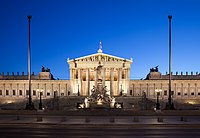National Assembly of Vierzland: Difference between revisions
No edit summary |
No edit summary |
||
| Line 1: | Line 1: | ||
{{Infobox legislature | {{Infobox legislature | ||
| name = National Assembly of Vierzland | | name = National Assembly of Vierzland | ||
| native_name = ''{{small| | | native_name = ''{{small|Verfassunggebende Versammlung}}'' | ||
| native_name_lang = | | native_name_lang = | ||
| transcription_name = | | transcription_name = | ||
Revision as of 06:36, 6 January 2021
National Assembly of Vierzland Verfassunggebende Versammlung | |
|---|---|
Coat of arms of the assembly | |
| Type | |
| Type | |
| History | |
| Founded | 10 January 1990 |
| Disbanded | 4 January 1992 |
| Preceded by | Reichsthing |
| Succeeded by | Federal Assembly |
| Leadership | |
President of the Assembly | |
Deputy President of the Assembly | Joachim Holtz |
Chairman of the Drafting Committee | |
| Structure | |
| Seats | 372 |
Length of term | Undetermined |
| Elections | |
| First-past-the-post | |
First election | 3 February 1990 |
| Meeting place | |
 | |
| Ehrepalast Adtrus, Vierzland | |
The National Assembly of Vierzland, officially the Verfassunggebende Versammlung (Vierz: lit. Constitution-giving assembly), was a legislative body created under the Werner Declaration with the purpose of writing and ratifying a new constitution for Vierzland. It was created in January 1990, elected in February, and dissolved in January 1992 after the signing of the new constitution.
The Vierz Revolution of the 1980s prompted the legal dissolution of the Vierz Empire by Chancellor Heinrich Werner in 1990. This was accompanied by the termination of the Reichsthing, the imperial legislature, and all other political institutions created under the Constitution of the Vierz Empire. Thus, the need for a new legislature and constitution was critical.
Elections were held for the assembly on 3 February 1990. While officially non-partisan, most elected deputies belonged to or were friendly with the United Republicans. The resulting constitution generally matched the ideological alignment and demands of the party: republicanism, liberalism, and secularism.